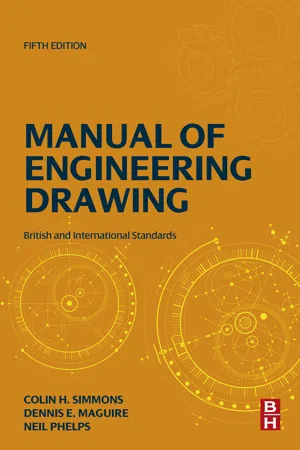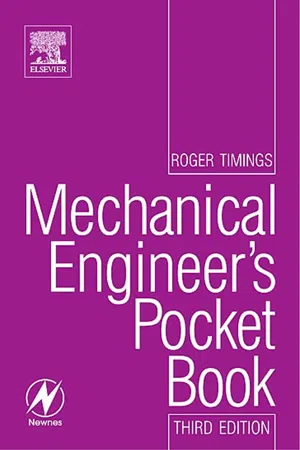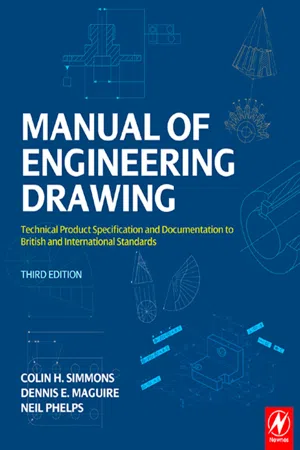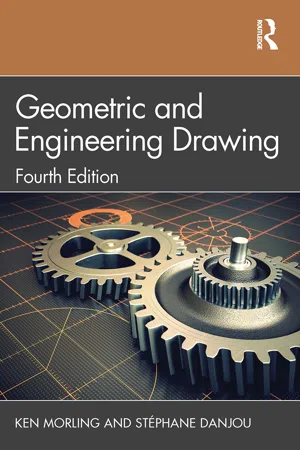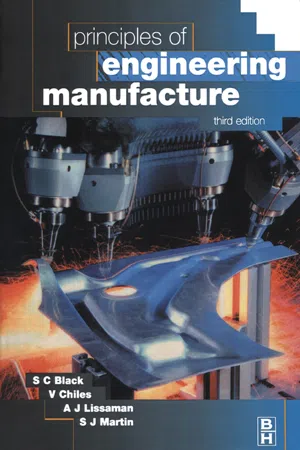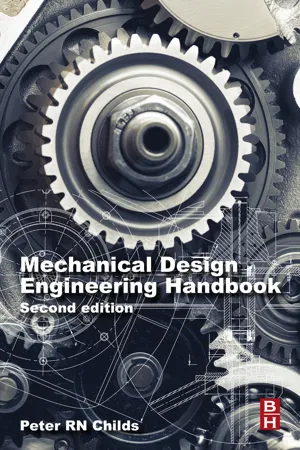Technology & Engineering
Limits and Fits
Limits and fits refer to the allowable variations in dimensions of mating parts in engineering. The "limit" is the maximum and minimum size of a part, while the "fit" is the range of tightness or looseness between mating parts. These standards ensure that parts fit together properly and function as intended, and are crucial for the interchangeability and assembly of mechanical components.
Written by Perlego with AI-assistance
Related key terms
Related key terms
1 of 4
Related key terms
1 of 3
8 Key excerpts on "Limits and Fits"
- eBook - ePub
Manual of Engineering Drawing
British and International Standards
- Colin H. Simmons, Dennis E. Maguire, Neil Phelps(Authors)
- 2020(Publication Date)
- Butterworth-Heinemann(Publisher)
21Limits and Fits
Abstract
To ensure that an assembly will function correctly, its component parts must fit together in a predictable manner. In practice, no component can be manufactured to an exact size, and one of the problems facing the designer is to decide the upper and lower limits of size which are acceptable for each of the dimensions used to define shape and form and which will ensure satisfactory operation in service. Based on the BS4500 series of fits (Hole and Shaft based) this chapter extensively the subject of Limits and Fits and includes an example of when they may not be appropriate for use. BS4500A (Hole Basis) and BS4500B (Shaft Basis) data sheets are reproduced for reference.Keywords
Limits; Fits; Tolerance; Size; FormTo ensure that an assembly will function correctly, its component parts must fit together in a predictable manner. Now, in practice, no component can be manufactured to an exact size, and one of the problems facing the designer is to decide the upper and lower limits of size which are acceptable for each of the dimensions used to define shape and form and which will ensure satisfactory operation in service. For example, a dimension of 10±0.02 means that a part will be acceptable if manufactured anywhere between the limits of size of 9.98 and 10.02mm. The present system of manufacture of interchangeable parts was brought about by the advent of and the needs of mass production, and has the following advantages.- 1. Instead of ‘fitting’ components together, which requires some adjustment of size and a high degree of skill, they can be ‘assembled’.
- 2. An assembly can be serviced by replacing defective parts with components manufactured to within the same range of dimensions.
- 3. Parts can be produced in large quantities, in some cases with less demand on the skill of the operator. Invariably this requires the use of special-purpose machines, tools, jigs, fixtures, and gauges: but the final cost of each component will be far less than if made separately by a skilled craftsman.
- eBook - ePub
Manual of Engineering Drawing
Technical Product Specification and Documentation to British and International Standards
- Colin H. Simmons, Dennis E. Maguire(Authors)
- 2012(Publication Date)
- Butterworth-Heinemann(Publisher)
Chapter 21
Limits and Fits
To ensure that an assembly will function correctly, its component parts must fit together in a predictable manner. Now, in practice, no component can be manufactured to an exact size, and one of the problems facing the designer is to decide the upper and lower limits of size which are acceptable for each of the dimensions used to define shape and form and which will ensure satisfactory operation in service. For example, a dimension of 10 ± 0.02 means that a part will be acceptable if manufactured anywhere between the limits of size of 9.98 and 10.02 mm. The present system of manufacture of interchangeable parts was brought about by the advent of and the needs of mass production, and has the following advantages.1. Instead of ‘fitting’ components together, which requires some adjustment of size and a high degree of skill, they can be ‘assembled’. 2. An assembly can be serviced by replacing defective parts with components manufactured to within the same range of dimensions.3. Parts can be produced in large quantities, in some cases with less demand on the skill of the operator. Invariably this requires the use of special-purpose machines, tools, jigs, fixtures, and gauges: but the final cost of each component will be far less than if made separately by a skilled craftsman.It should be noted, however, that full interchangeability is not always necessary in practice; neither is it always feasible, especially when the dimensions are required to be controlled very closely in size. Many units used in the construction of motor vehicles are assembled after an elaborate inspection process has sorted the components into different groups according to size. Suppose, for example, that it was required to maintain the clearance between a piston and a cylinder to within 0.012 mm. To maintain full interchangeability would require both the piston and the cylinder bores to be finished to a tolerance of 0.006 mm, which would be difficult to maintain and also uneconomical to produce. In practice it is possible to manufacture both bores and pistons to within a tolerance of 0.06 mm and then divide them into groups for assembly; this involves the gauging of each component. - eBook - ePub
Design for Manufacturing
A Structured Approach
- Corrado Poli(Author)
- 2001(Publication Date)
- Butterworth-Heinemann(Publisher)
a , is 0.02.The size by reference to which the limits of size are fixed is called the basic size. For the parts shown in Figure 2.4 the basic size is 2.Tolerances can be applied bilaterally, as shown in Figure 2.4 , or unilaterally as indicated below.When parts must fit together (a shaft inside a hole, for example), the tolerances on both parts must be considered simultaneously. The relationship resulting from the difference, before assembly, between the sizes of the two parts to be assembled is called the fit.A clearance exists if the diameter of the hole is greater than the diameter of the shaft. This allows for relative movement (translation or rotation) between the two parts. An interference exists if the diameter of the hole is less than the diameter of the shaft. This is used when an alignment of parts is required or stiffness is needed.As stated above, regardless of the process used, there will always be variations in dimensions from the nominal, and not all parts produced will have the same dimensions. Hence, in the case of a shaft and hole, a clearance fit exists if the minimum hole diameter is greater than the maximum shaft diameter. An interference fit is said to exist if the maximum hole diameter is less than the minimum shaft diameter. A transitional fit is said to exist if we sometimes get clearance and sometimes get interference.At times there is a tendency to confuse tolerance with allowance. Allowance is the intentional desired difference between the dimensions of two mating parts. It is the difference between the dimensions of the largest interior-fitting part and the smallest exterior-fitting part. In the case of a clearance fit, allowance is the minimum clearance between the two parts. In the case of an interference fit, allowance is the maximum interference between two mating parts. - eBook - ePub
- Roger Timings(Author)
- 2005(Publication Date)
- Newnes(Publisher)
7Linear and Geometric Tolerancing of Dimensions
7.1 Linear tolerancing
7.1.1 Limits and Fits
It is not possible to work to an exact size nor is it possible to measure to an exact size. Therefore dimensions are given limits of size. Providing the dimensions of a part lie within the limits of size set by the designer, then the part will function correctly. Similarly the dimensions of gauges and measuring equipment are given limits of size. As a general rule, the limits of size allocated to gauges and measuring instruments are approximately 10 times more accurate than the dimensions they are intended to check (gauges) or measure (measuring instruments).The upper and lower sizes of a dimension are called the limits and the difference in size between the limits is called the tolerance . The terms associated with Limits and Fits can be summarized as follows:•Nominal size : This is the dimension by which a feature is identified for convenience. For example, a slot whose actual width is 25.15 mm would be known as the 25- mm wide slot.•Basic size : This is the exact functional size from which the limits are derived by application of the necessary allowance and tolerances. The basic size and the nominal size are often the same.•Actual size : The measured size corrected to what it would be at 20°C.•Limits : These are the high and low values of size between which the size of a component feature may lie. For example, if the lower limit of a hole is 25.05 mm and the upper limit of the same hole is 25.15 mm, then a hole which is 25.1 mm diameter is within limits and is acceptable. Examples are shown in Fig. 7.1(a) .Figure 7.1 Toleranced dimensions (a) methods of tolerancing; (b) unilateral tolerance and (c) bilateral tolerance. Dimensions in mm. Engineering Fundamental: Timings: Elsevier (Newnes).•Tolerance : This is the difference between the limits of size. That is, the upper limit minus the lower limit. Tolerances may be bilateral or unilateral as shown in Fig. 7.1(b) and (c) - eBook - ePub
Manual of Engineering Drawing
Technical Product Specification and Documentation to British and International Standards
- Colin H. Simmons, Dennis E. Maguire(Authors)
- 2009(Publication Date)
- Butterworth-Heinemann(Publisher)
Chapter Limits and Fits
To ensure that an assembly will function correctly, its component parts must fit together in a predictable manner. Now, in practice, no component can be manufactured to an exact size, and one of the problems facing the designer is to decide the upper and lower limits of size which are acceptable for each of the dimensions used to define shape and form and which will ensure satisfactory operation in service. For example, a dimension of 10 ± 0.02 means that a part will be acceptable if manufactured anywhere between the limits of size of 9.98 and 10.02 mm. The present system of manufacture of interchangeable parts was brought about by the advent of and the needs of mass production, and has the following advantages.It should be noted, however, that full interchangeability is not always necessary in practice; neither is it always feasible, especially when the dimensions are required to be controlled very closely in size. Many units used in the construction of motor vehicles are assembled after an elaborate inspection process has sorted the components into different groups according to size. Suppose, for example, that it was required to maintain the clearance between a piston and a cylinder to within 0.012 mm. To maintain full interchangeability would require both the piston and the cylinder bores to be finished to a tolerance of 0.006 mm, which would be difficult to maintain and also uneconomic to produce. In practice it is possible to manufacture both bores and pistons to within a tolerance of 0.06 mm and then divide them into groups for assembly; this involves the gauging of each component. - eBook - ePub
- Ken Morling, Stéphane Danjou(Authors)
- 2022(Publication Date)
- Routledge(Publisher)
If the two tolerance intervals overlap each other so that the internal mating part could be smaller or larger than the external mating part, then this is a transition fit. Depending on the actual sizes of the two mating parts, it can result in a very small clearance or in a small interference. Transition fits are used when accurate location is required. Examples are machine elements on a shaft such as gears, pulleys and bearings.Interference Fit
If the internal mating part will always be larger than the external mating part, then this is an interference fit. Since usually we have to apply a certain force to assemble two mating parts in an interference fit, this is also called force fit or shrink fit. As an example, whenever forces need to be transmitted from one component to the other, interference fits are used. Examples are bushings in a wheel hub, clutches on a shaft end and rocker arms.Within each fit category it is possible to define size limits so that the resulting fit becomes looser or tighter. The selection of a fit during the design stage needs special attention since accurate fits result in higher manufacturing cost. Tighter fits usually require more effort for assembly. As an example, in case of interference fits special tools are needed.It seems that a more detailed classification is necessary if we want to further specify the degree of clearance or interference. With ISO 286–1, a code system for tolerances on linear sizes is introduced.8.2.3 The ISO Code System
Since it is theoretically possible to specify arbitrary deviations for two mating parts, the code system presented by the International Organization for Standardization allows a reduction of possible combinations of tolerance intervals. In addition, interchangeability can be achieved by standardising values for tolerances and deviations. Instead of indicating lower and upper limits for two mating parts on a drawing, each tolerance interval is allocated a code, consisting of a letter and a number (Figure 8.10 ). The combination of reference letter and number is called the tolerance class - eBook - ePub
- V. Chiles, S. Black, A. Lissaman, S. Martin(Authors)
- 1996(Publication Date)
- Butterworth-Heinemann(Publisher)
For dimensions where tolerances are not of significance to the function, the designer’s drawing work is simplified by using general tolerances. This means that dimensions are given without tolerance information and that a note on the drawing describes what tolerances are applicable for dimensions for which tolerances have not been set. The fit gives the dimensional difference between two related parts. This difference will give rise to a positive or negative play between the parts.To facilitate design work there are ready for use system tolerances available. There are three different types of fit (Figure 16.7 ): play fit (A), transition fit (B) and grip fit (C). The basic measurement gives the exact diameter of the hole or shaft in Figure 16.8 . From this basic dimension an upper measurement (D) and a lower one (E) known as limit measurements, are allowed. Together, the limit measurements form the tolerance width (F).Figure 16.7 (A) Clearance fit; (B) transition fit; (C) interference fit.Figure 16.8 Tolerancing on shaft.In accordance with the ISO system, the tolerance position of a hole is shown in capitals and the tolerance position of a shaft in lower case letters. J and JS plus j and js tolerances respectively, lie symmetrically around the basic dimension, while other tolerances permit greater or smaller over and under sizes or, alternatively, a tolerance width in one direction only. The type of fit depends not only on the tolerance widths for holes and shafts, but also on the mutual tolerance position of the parts. The tolerance width or degree of tolerance is shown by a figure, where higher figures indicate larger tolerance widths. With the ISO system the fit is indicated by an oblique stroke between the tolerance information relating to the hole and to the shaft, for instance H8/h7.Measurement adjustment
Sometimes it is possible to exceed the specified tolerance limits when one or more measurement work in conjunction. It is then necessary to ensure that the function requirements are met. When adjustments are made to measurements, subsequent inspections are usually made with function gauges (Figure 16.9 - eBook - ePub
- Peter Childs(Author)
- 2018(Publication Date)
- Butterworth-Heinemann(Publisher)
19Tolerancing and precision engineering
Abstract
The aims of this chapter are to introduce the concepts of component and process variability and the allocation of component tolerances. The selection of suitable tolerances for the assembly of components is a key requirement in the development of a machine design for given functionality, and this requires an understanding of process capability as well as careful attention to the detailing of the allowable variability component dimensions. The principles of engineering tolerancing can also be applied to model the variability of a process or function.Keywords
Tolerances; Tolerancing; Standard; Fits; Interference; Geometric; Statistical; Quality; Assurance; SelectionChapter Outline- 19.1 Introduction
- 19.2 Component tolerances
- 19.2.1 Standard fits for holes and shafts
- 19.2.2 Interference fits
- 19.2.3 Machine capability
- 19.2.4 Geometric tolerancing
- 19.3 Statistical tolerancing
- 19.3.1 Sure-fit or extreme variability
- 19.3.2 Linear functions or tolerance chains
- 19.3.3 Several independent, uncorrelated random variables
- 19.3.4 Statistical design techniques and quality assurance
- 19.4 Precision engineering and case studies
- 19.4.1 Axial compressor clearance case study
- 19.4.2 Cordless and corded hand tools case study
- 19.4.3 Robot transmission case study
- 19.5 Conclusions
- References
- Standards
- Further reading
Nomenclature Generally, preferred SI units have been stated.a internal radius of inner cylinder (m), inner radius (m)
Index pages curate the most relevant extracts from our library of academic textbooks. They’ve been created using an in-house natural language model (NLM), each adding context and meaning to key research topics.
Explore more topic indexes
Explore more topic indexes
1 of 6
Explore more topic indexes
1 of 4
